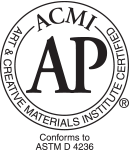
Classic Crackles© add a level of sophistication and dimension to your designs.
Cone 06 chips have been fired flat in oxidation on white earthenware body.
Cone 6 chips have been fired flat in oxidation on white stoneware body.
Classic Crackles© are glazes that are designed to “craze”; that is, develop subtle surface cracks in the finished glaze.
The cracked effect has traditionally been used on home décor pieces by designers looking to create a vintage or antiqued appeal to their pottery.
Shake well. We recommend a broad, soft brush, such as a CB-604 #4 Soft Fan Brush, to apply the glaze. Apply three coats to properly fired shelf cone 04 bisque. Fire to shelf cone 06. After firing, wipe an acrylic or ink over the ware and wipe off, allowing the ink to fill and highlight the cracks.


Classic Crackles© glazes have been certified as AP Non-Toxic, safe for use by artists of all ages when used according to manufacturer’s directions. However, they are not recommended for dinnerware as these glazes can exhibit surface textures such as cracks and crevices. While the glazed surface may pass lead & cadmium leach tests, and therefore legally considered Food Safe, attempts to adequately clean the textured surface may cause the underlying porous ware to absorb water and fail. Recommended for ornamental use only.
The “crackle pattern” in the glaze is actually a firing defect called “crazing.” Simply put, crazing is occurs when the glaze shrinks more than the body. The tension of the glaze on the body causes the glaze to crack.
In the case of Classic Crackles© it is our intent to develop a glaze that will not fit an earthenware body. While we design and test for a common cone 06 earthenware body we know body composition can vary. If you having difficulty obtaining a crackle pattern, one potential issue may be that the glaze “fits” the body too well. There may be delayed crackling 1 -3 days later.
Some things you can try to instigate cracking:
Yes, you can do both. Classic Crackles© are transparent and easily allow designs on the bisque surface to appear through. Glazes such as Stroke & Coat® and Foundations work very well for design work (not all over coverage) under Classic Crackles©. Use only 1-2 coats of the glaze under to create the design; too much color may prevent the crackle from developing properly. Apply three coats of the crackle glaze and fire to shelf cone 06. Design work on top of Classic Crackles© will remain intact after firing as the crackle glaze does not move.
Products such as Gold and Mother of Pearl are compatible.
You can use non fired products or fired products to highlight the crackle pattern. If you plan to highlight the crackle: handle the glazed ware with gloves or a clean rag to avoid getting dirt in the cracks. Oils from your hand can also prevent the antiquing color from filling in the cracks. While black inks and glaze are commonly chosen, you can chose any color to accent the cracks.
Fired products: you can use any glaze to fill in the cracks. Wipe glaze into the cracks with a clean rag and refire to cone 06.
Non fired products: use acrylics, mineral spirit stains or India ink to stain the cracks. Wipe onto the piece with a clean rag until the cracks are adequately filled in.
Crackle glazes place stress on the ware during firing. To prevent containers, such as vases, from splitting or cracking apart make sure a compatible (not stiff) non-toxic glaze is used to coat the inside of the vase. Compatible Mayco glazes include Foundations, NT-Clear. Allow ample room between pieces in the kiln for air circulation.